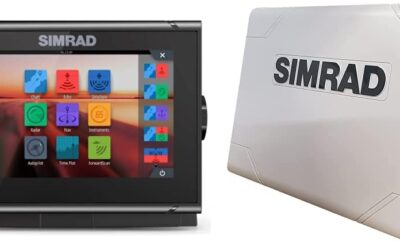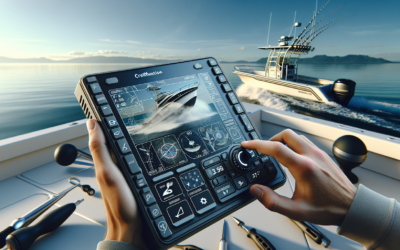Finding the perfect fish finder that can withstand the elements and deliver reliable performance can be a daunting task. That’s where the importance of robustness comes into play. In this article, we will explore the key factors to consider when evaluating the material and build quality of fish finders. From the durability of the housing to the sturdiness of the transducer, we will guide you through the essentials, ensuring that you make an informed decision when purchasing your next fish finder. So, let’s dive in and discover the world of robustness in fish finders!
Importance of Robustness in Fish Finders
Fish finders are an essential tool for anglers, helping them locate fish and improve their fishing success. When investing in a fish finder, it is crucial to consider its robustness. Robustness refers to the ability of a fish finder to withstand the rigors of fishing conditions, ensuring its durability, reliability, and longevity. A robust fish finder will not only withstand regular wear and tear but also perform consistently, giving you accurate and reliable readings. Let’s explore the importance of robustness in fish finders in more detail.
Enhances Durability
Fishing often involves rough handling, exposure to the elements, and constant movement. Therefore, a durable fish finder is paramount. A robust fish finder is built to withstand physical impacts, such as accidental drops or bumps against the boat or rocks. The materials used in its construction play a vital role in determining its durability. By investing in a robust fish finder, you can be confident that it will endure the test of time and continue to provide reliable performance even in challenging fishing conditions.
Ensures Reliable Performance
Reliability is a crucial factor in any electronic device, and fish finders are no exception. A robust fish finder is designed to function consistently, providing accurate readings and minimizing the chances of malfunctioning. When you’re out on the water and relying on your fish finder to guide you to fish, you need it to perform reliably every time. A robust fish finder will not only give you peace of mind but also enhance your fishing experience by providing you with accurate and real-time data.
Increases Longevity
Investing in a fish finder is a long-term commitment, and you want your device to last for years. A robust fish finder is built to withstand the test of time, allowing you to enjoy its benefits for an extended period. By ensuring the durability and reliability of your fish finder, you are safeguarding your investment and avoiding the need for frequent replacements. A robust fish finder can ultimately save you money in the long run and provide you with consistent fishing success for years to come.
Factors Affecting Robustness
Several factors play a crucial role in determining the robustness of a fish finder. These factors include the choice of materials, build quality, waterproofing, and resistance to environmental factors. Let’s explore each of these factors in more detail.
Choice of Materials
The choice of materials used in the construction of a fish finder significantly impacts its robustness. Here are some key considerations when evaluating the choice of materials:
Impact Resistance
A robust fish finder should be able to withstand accidental impacts, such as drops or bumps. Materials with high impact resistance, such as reinforced plastics or metals, are desirable in fish finder construction. These materials help protect the internal components from damage and ensure the device remains functional even after accidental mishaps.
Corrosion Resistance
Fishing environments can be harsh and corrosive, especially in saltwater conditions. A robust fish finder should be constructed using corrosion-resistant materials to prevent the device from corroding over time. Stainless steel, corrosion-resistant plastics, and special coatings are commonly used to enhance the fish finder’s longevity and performance in corrosive environments.
Weight Considerations
Weight plays a crucial role in the overall functionality and portability of a fish finder. While robustness is important, the materials used should not compromise the device’s weight and portability. Manufacturers strike a balance between robustness and weight, ensuring that the fish finder remains lightweight and easy to handle while still being durable and capable of withstanding tough fishing conditions.
Temperature Tolerance
Fishing can take you to various environments with fluctuating temperature conditions. A robust fish finder should have the ability to tolerate a wide range of temperatures, ensuring its functionality in both extreme cold and hot conditions. The materials chosen should have a high thermal resistance to prevent damage or malfunctioning due to temperature extremes.
Build Quality
Apart from the choice of materials, the build quality of a fish finder is equally important in determining its robustness. Here are some key factors to consider when evaluating the build quality of a fish finder:
Structural Integrity
A robust fish finder should be structurally sound and well-built to withstand the challenging conditions it will be exposed to while fishing. The housing and internal components should be securely attached, eliminating any potential weak points or vulnerabilities that could compromise the device’s functionality. A fish finder with excellent structural integrity ensures that it can endure vibrations, impacts, and other physical stresses without suffering any damage.
Sealing and Enclosure
Effective sealing and enclosure are essential features that contribute to the overall robustness of a fish finder. Seals and gaskets should be utilized to prevent water, dust, and other particles from infiltrating the device. High-quality enclosures with proper ingress protection (IP) ratings play a crucial role in achieving waterproofing and protecting the internal components from environmental factors.
Connectivity
Connectivity features, such as ports, cables, and connectors, should be robust and reliable to ensure seamless communication between the fish finder and other devices, such as GPS or chartplotters. A fish finder with strong connectivity ensures that data transmission is not affected by external factors, maintaining accuracy and reliability in transmitting and receiving information.
Control Panel Design
The design and layout of the fish finder’s control panel contribute to its overall robustness. Intuitive and user-friendly controls enable easy operation even in challenging fishing conditions. Buttons and dials should be well-positioned and robustly built to withstand constant use and resist damage from accidental spills or impacts.
Waterproofing
Fishing involves exposure to water, making waterproofing a crucial aspect of fish finder robustness. A robust fish finder should have effective waterproofing measures to endure both splashes and full immersion. Here are some key factors to consider when evaluating the waterproofing capabilities of a fish finder:
IPX Ratings
The Ingress Protection (IP) rating system is used to indicate a device’s resistance to water and dust. Look for a fish finder with a high IPX rating, indicating superior water resistance. The rating is typically accompanied by a number (IPX7, IPX8, etc.), with higher numbers indicating better protection against water intrusion. A high IPX rating ensures that your fish finder remains functional even when subject to water exposure.
Submersion Depth
In addition to the IPX rating, it is important to consider the maximum submersion depth specified by the manufacturer. This specification indicates the depth to which the fish finder can be submerged without compromising its functionality or integrity. The deeper the submersion depth, the more robust the fish finder is in terms of waterproofing.
Sealing Mechanisms
The presence of effective sealing mechanisms is vital for a fish finder to be considered robust in terms of waterproofing. O-rings and gaskets are commonly used to create watertight seals, preventing water from entering the internal components. Robust sealing mechanisms ensure that the fish finder remains fully functional even in wet and demanding fishing conditions.
Resistance to Environmental Factors
Fishing environments pose a variety of challenges, including exposure to UV rays, saltwater corrosion, and extreme temperatures. A robust fish finder should be resistant to these environmental factors to ensure its longevity and functionality. Here are some key factors to consider when evaluating a fish finder’s resistance to environmental factors:
UV Resistance
Exposure to sunlight for prolonged periods can cause damage to fish finder screens and housings. A robust fish finder should have UV-resistant coatings or materials that can withstand the harmful effects of UV rays. This resistance prevents discoloration, deterioration, and loss of visibility, ensuring that the fish finder remains functional even in sunny fishing conditions.
Saltwater Resistance
Saltwater is particularly corrosive and can cause significant damage to electronic devices. A robust fish finder designed for saltwater environments should have specialized materials and coatings that provide effective resistance to saltwater corrosion. By investing in a fish finder with excellent saltwater resistance, you can ensure its longevity and continued reliable performance in marine environments.
Extreme Temperature Resistance
Fishing can take you to locations with extreme temperature conditions, such as freezing cold or scorching heat. A robust fish finder should have the ability to withstand these extreme temperatures without malfunctioning or suffering damage. This resilience ensures that the fish finder remains functional in various fishing conditions, providing you with accurate and reliable readings regardless of the temperature extremes.
Testing Methods for Robustness Evaluation
To ensure the robustness of fish finders, manufacturers subject their devices to various testing methods. These tests evaluate the fish finder’s ability to withstand the rigors of fishing conditions. Here are some common testing methods used for robustness evaluation:
Vibration Testing
Vibration testing simulates the vibrations a fish finder may experience while mounted on a boat or subjected to other forms of movement. This test ensures that the fish finder can withstand vibrations without developing any internal damage or malfunctions. The test subjects the device to different frequency and amplitude levels, mimicking real-world scenarios and ensuring that the fish finder remains functional and accurate.
Drop Testing
Accidental drops are a common occurrence while fishing, especially in dynamic and unpredictable environments. Drop testing assesses the fish finder’s ability to withstand impacts from accidental drops. It simulates various drop scenarios and heights, ensuring that the device remains fully functional and undamaged even after a fall.
Water Immersion Testing
Water immersion testing evaluates the fish finder’s waterproofing capabilities. The device is subjected to prolonged exposure to water, verifying its ability to resist water intrusion and remain fully functional. This test is crucial for determining a fish finder’s ability to withstand the moisture and potential submersion it may encounter while fishing.
Functional Testing
Functional testing assesses the overall performance and functionality of the fish finder. It tests the accuracy and reliability of the device’s readings, ensuring that it consistently provides accurate fish detection and depth information. Functional testing also evaluates the user interface and control panel, ensuring they are user-friendly and easy to operate in different fishing conditions.
By subjecting their fish finders to these rigorous testing methods, manufacturers can ensure that the devices meet high standards of robustness and can withstand the demanding fishing conditions anglers face.
Considerations for Fishing Conditions
Different fishing conditions require different levels of robustness in fish finders. When selecting a fish finder, it is essential to consider the fishing environments you will be encountering. Here are some considerations for fishing conditions:
Freshwater Environments
In freshwater environments, the primary concern is usually durability and resistance to impact and moisture. Freshwater fishing often involves navigating through rocks, submerged logs, and other physical obstacles. Therefore, a fish finder should have strong impact resistance to withstand accidental bumps and drops. Additionally, effective sealing mechanisms are crucial to prevent water penetration and damage.
Saltwater Environments
Saltwater environments present additional challenges, primarily due to the corrosive nature of saltwater. When fishing in saltwater, it is essential to invest in a fish finder with excellent saltwater resistance. The materials used should be highly corrosion-resistant, and the device should have effective sealing mechanisms to prevent saltwater intrusion. Additionally, UV resistance is vital to withstand the intense sunlight often encountered in marine environments.
Shallow Waters
When fishing in shallow waters, the risk of impact with the bottom or other submerged obstacles increases. A robust fish finder with strong impact resistance is essential for these conditions. Additionally, the device should have effective waterproofing capabilities to endure splashes and occasional submersion.
Deep Waters
Deep-water fishing often involves longer trips and more prolonged exposure to harsh conditions. In these scenarios, a fish finder should have excellent durability and robustness. Materials with high corrosion resistance and effective sealing mechanisms are crucial to withstand the pressure and constant exposure to water at greater depths. Additionally, the device should be well-designed to resist the potential impacts and vibrations experienced during deep-water fishing.
By considering the fishing conditions you will be encountering, you can select a fish finder that offers the appropriate level of robustness, ensuring its longevity and optimal performance.
Balancing Robustness and Price
When purchasing a fish finder, it is important to find the right balance between robustness and price. Fish finders are available at various price points, each offering different levels of robustness and features. Here are some considerations based on different price ranges:
High-End Fish Finders
High-end fish finders often come with advanced features and superior build quality. These devices are designed with robustness in mind and are built to withstand rigorous fishing conditions. Materials used in high-end fish finders are typically of the highest quality, offering exceptional impact and corrosion resistance. These fish finders undergo extensive testing to ensure their durability and reliability. While high-end fish finders may come with a higher price tag, they provide anglers with unparalleled performance and longevity in challenging fishing environments.
Mid-Range Fish Finders
Mid-range fish finders strike a balance between robustness and affordability. They offer a good level of performance and durability without breaking the bank. While they may not have all the advanced features of high-end fish finders, they still provide reliable readings and withstand regular fishing conditions. Mid-range fish finders often use quality materials and undergo various testing methods to ensure their robustness. These devices offer a cost-effective solution without compromising on essential features and durability.
Budget Fish Finders
Budget fish finders are suitable for casual or occasional anglers who are seeking basic functionality at an affordable price. While they may not offer the same level of robustness as high-end or mid-range fish finders, they still provide basic fish detection and depth readings. Budget fish finders can be a viable option for those who are not regularly exposed to challenging fishing conditions or have a limited budget. However, it is important to manage expectations regarding their durability and longevity in more demanding fishing environments.
When considering the price of a fish finder, it is essential to assess your fishing needs and the environments you will be fishing in. It is always recommended to invest in a fish finder that meets your specific requirements and offers a suitable level of robustness, ensuring a more enjoyable and successful fishing experience.
Conclusion
Robustness is a vital factor to consider when purchasing a fish finder. It enhances the durability, reliability, and longevity of the device, ensuring that it can withstand the rigors of fishing conditions. Factors such as the choice of materials, build quality, waterproofing, and resistance to environmental factors all contribute to the overall robustness of a fish finder. By carefully evaluating these factors and considering the fishing conditions you will be encountering, you can select a fish finder that meets your unique needs. Balancing robustness and price is also important, considering the different price ranges and their corresponding levels of durability. By investing in a robust fish finder, you are not only safeguarding your investment but also enhancing your fishing experience and increasing your chances of success on the water.









